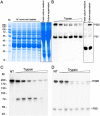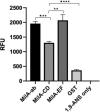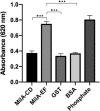Mycoplasma bovis Membrane Protein MilA Is a Multifunctional Lipase with Novel Lipid and Glycosaminoglycan Binding Activity
- PMID: 32253247
- PMCID: PMC7240078
- DOI: 10.1128/IAI.00945-19
Mycoplasma bovis Membrane Protein MilA Is a Multifunctional Lipase with Novel Lipid and Glycosaminoglycan Binding Activity
Abstract
The survival, replication, and virulence of mycoplasmas depend on their ability to capture and import host-derived nutrients using poorly characterized membrane proteins. Previous studies on the important bovine pathogen Mycoplasma bovis demonstrated that the amino-terminal end of an immunogenic 226-kDa (P226) protein, encoded by milA (the full-length product of which has a predicted molecular weight of 303 kDa), had lipase activity. The predicted sequence of MilA contains glycosaminoglycan binding motifs, as well as multiple copies of a domain of unknown function (DUF445) that is also found in apolipoproteins. We mutagenized the gene to facilitate expression of a series of regions spanning the gene in Escherichia coli Using monospecific antibodies against these recombinant proteins, we showed that MilA was proteolytically processed into 226-kDa and 50-kDa fragments that were both partitioned into the detergent phase by Triton X-114 phase fractionation. Trypsin treatment of intact cells showed that P226 was surface exposed. In vitro, the recombinant regions of MilA bound to 1-anilinonaphthalene-8-sulfonic acid and to a variety of lipids. The MilA fragments were also shown to bind heparin. Antibody against the carboxyl-terminal fragment inhibited the growth of M. bovisin vitro This carboxyl end also bound and hydrolyzed ATP, suggestive of a potential role as an autotransporter. Our studies have demonstrated that DUF445 has lipid binding activity and that MilA is a multifunctional protein that may play multiple roles in the pathogenesis of infection with M. bovis.
Keywords: ATPase activity; GAG; Mycoplasma bovis; immunogenicity; lipid binding; membrane protein.
Copyright © 2020 American Society for Microbiology.
Figures








Similar articles
-
Mycoplasma bovis mbfN Encodes a Novel LRR Lipoprotein That Undergoes Proteolytic Processing and Binds Host Extracellular Matrix Components.J Bacteriol. 2020 Dec 18;203(2):e00154-20. doi: 10.1128/JB.00154-20. Print 2020 Dec 18. J Bacteriol. 2020. PMID: 33077633 Free PMC article.
-
Development of a recombinant protein-based enzyme-linked immunosorbent assay for diagnosis of Mycoplasma bovis infection in cattle.Clin Vaccine Immunol. 2014 Feb;21(2):196-202. doi: 10.1128/CVI.00670-13. Epub 2013 Dec 11. Clin Vaccine Immunol. 2014. PMID: 24334686 Free PMC article.
-
Fructose-1,6-bisphosphate aldolase of Mycoplasma bovis is a plasminogen-binding adhesin.Microb Pathog. 2018 Nov;124:230-237. doi: 10.1016/j.micpath.2018.08.032. Epub 2018 Aug 22. Microb Pathog. 2018. PMID: 30142464
-
Proteomics analysis and its role in elucidation of functionally significant proteins in Mycoplasma bovis.Microb Pathog. 2017 Oct;111:50-59. doi: 10.1016/j.micpath.2017.08.024. Epub 2017 Aug 18. Microb Pathog. 2017. PMID: 28826762 Review.
-
Mycoplasma bovis in respiratory disease of feedlot cattle.Vet Clin North Am Food Anim Pract. 2010 Jul;26(2):365-79. doi: 10.1016/j.cvfa.2010.03.003. Epub 2010 May 14. Vet Clin North Am Food Anim Pract. 2010. PMID: 20619190 Review.
Cited by
-
Infection strategies of mycoplasmas: Unraveling the panoply of virulence factors.Virulence. 2021 Dec;12(1):788-817. doi: 10.1080/21505594.2021.1889813. Virulence. 2021. PMID: 33704021 Free PMC article. Review.
-
A candidate competitive ELISA based on monoclonal antibody 3A8 for diagnosis of contagious bovine pleuropneumonia.Appl Microbiol Biotechnol. 2024 Apr 8;108(1):290. doi: 10.1007/s00253-024-13127-0. Appl Microbiol Biotechnol. 2024. PMID: 38587616 Free PMC article.
-
Mycoplasma bovis mbfN Encodes a Novel LRR Lipoprotein That Undergoes Proteolytic Processing and Binds Host Extracellular Matrix Components.J Bacteriol. 2020 Dec 18;203(2):e00154-20. doi: 10.1128/JB.00154-20. Print 2020 Dec 18. J Bacteriol. 2020. PMID: 33077633 Free PMC article.
-
A novel phage-displayed MilA ELISA for detection of antibodies against Myc. bovis in bovine milk.J Appl Microbiol. 2022 Sep;133(3):1496-1505. doi: 10.1111/jam.15655. Epub 2022 Jun 22. J Appl Microbiol. 2022. PMID: 35686656 Free PMC article.
-
Extracellular vesicles of minimalistic Mollicutes as mediators of immune modulation and horizontal gene transfer.Commun Biol. 2025 Apr 29;8(1):674. doi: 10.1038/s42003-025-08099-4. Commun Biol. 2025. PMID: 40301684 Free PMC article.
References
-
- Buchenau I, Poumarat F, Le Grand D, Linkner H, Rosengarten R, Hewicker-Trautwein M. 2010. Expression of Mycoplasma bovis variable surface membrane proteins in the respiratory tract of calves after experimental infection with a clonal variant of Mycoplasma bovis type strain PG45. Res Vet Sci 89:223–229. doi:10.1016/j.rvsc.2010.03.014. - DOI - PubMed
Publication types
MeSH terms
Substances
LinkOut - more resources
Full Text Sources

